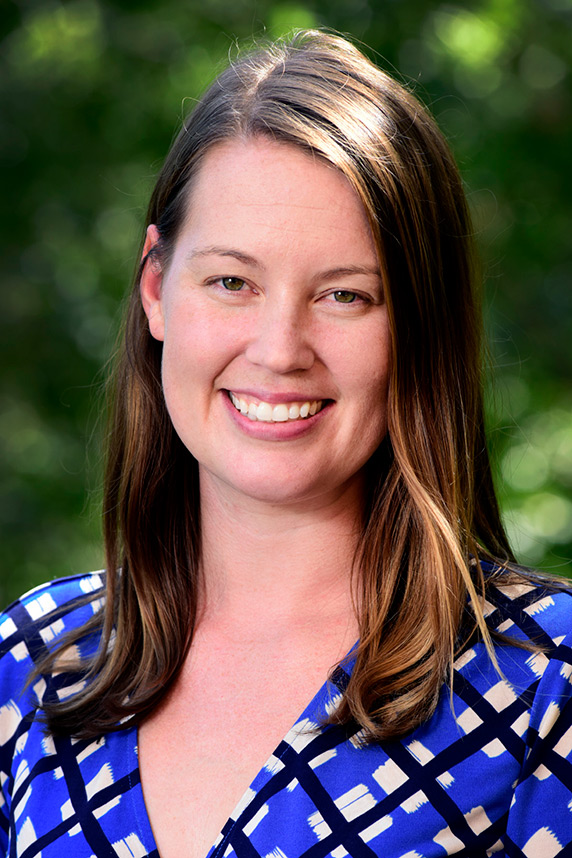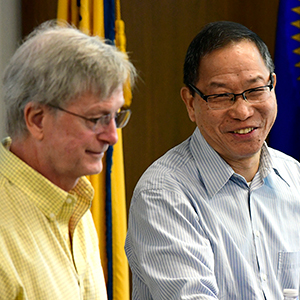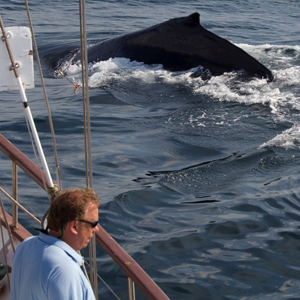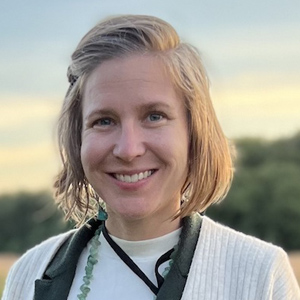This month, epidemiologist Alexandra White, Ph.D., moves into her role as a National Institutes of Health (NIH) Earl Stadtman Tenure-Track Investigator and head of the Environment and Cancer Epidemiology Group. Her research focus is on environmental and lifestyle risk factors for breast cancer.
Rising star with NIEHS history
 As a graduate student at UNC, White worked on the Long Island Breast Cancer Study project, which was one of the first studies designed to evaluate the role of the environment — a potentially modifiable factor — on breast cancer risk. (Photo courtesy of Steve McCaw)
As a graduate student at UNC, White worked on the Long Island Breast Cancer Study project, which was one of the first studies designed to evaluate the role of the environment — a potentially modifiable factor — on breast cancer risk. (Photo courtesy of Steve McCaw)White already knows her way around the institute and its campus. She was a postdoctoral fellow in the Chronic Disease Epidemiology Group, headed by Epidemiology Branch Chief Dale Sandler, Ph.D., before stepping into her new role.
Her career at NIEHS extends even further back. She worked as a postbaccalaureate fellow in 2009-2010 and credits that experience for her choice to pursue epidemiology at the University of North Carolina at Chapel Hill (UNC).
“I came here with a degree in molecular biology, without a lot of exposure to epidemiology,” she said of her postbaccalaureate. “That experience was critical for introducing me to environmental epidemiology and the different types of research I could do as an epidemiologist.”
“Dr. White is a rising star in the field of environmental epidemiology and our latest recruit from the highly competitive NIH-wide Earl Stadtman investigator search,” said NIEHS Scientific Director Darryl Zeldin, M.D. “Her work in the Sister Study to identify environmental and lifestyle risk factors for cancer and other chronic conditions will help scientists better understand underlying biological mechanisms of the disease.”
Air toxics and breast cancer risk
“My current research has been looking at exposure to hazardous air toxics — specifically airborne metals — using a database from the U.S. Environmental Protection Agency,” said White. “I’ve linked it with the Sister Study cohort as well as a nationwide mammography registry.”
Using these resources, White was able to identify certain metals, including cadmium and lead, that were associated with a higher risk of breast cancer. In addition, she found that women living in areas with higher airborne metals were more likely to have dense breasts, which is an important risk factor for developing breast cancer.
“There is a lot of existing research on risk factors for breast cancer but research is limited on the impact of the environment on breast cancer risk,” she explained. “An important thing about the work we do here is that we try to fill that gap. It is really vital to evaluate the question in rigorous ways, and the Sister Study is a valuable resource.”
“I am excited to see Dr. White take this next step in her career by becoming a tenure-track investigator,” said Sandler. “Her work complements that of others in the branch and her broad experience and interests in environmental exposures position her to lead the next generation of breast cancer research.”
What next?
With her research group. White plans to extend her research on metals and air pollution. “We are exposed to metals through many sources, not just air,” she pointed out. “I want to measure biomarkers, which integrate exposure across sources, and evaluate how multiple metals may act together to influence breast cancer risk as a way to better mimic real-life exposure patterns.
“With environmental exposures such as air pollution, often the effect sizes are small, but because exposures are so widespread, it is an important public health consideration,” she added. Sister Study data, pooled with other large cohorts, will facilitate her efforts to better evaluate risk between air pollution and breast cancer.
When not setting up her next big project, White, who grew up in Colorado, likes to ski, hike, and spend time with her son, age 18 months.
Citations:
White AJ, D'Aloisio AA, Nichols HB, DeRoo LA, Sandler DP. 2017. Breast cancer and exposure to tobacco smoke during potential windows of susceptibility. Cancer Causes Control 28(7):667−675.
White AJ, O'Brien KM, Niehoff NM, Carroll R, Sandler DP. 2019. Metallic air pollutants and breast cancer risk in a nationwide cohort study. Epidemiology 30(1):20−28.
White AJ, Sandler DP. 2017. Indoor wood-burning stove and fireplace use and breast cancer in a prospective cohort study. Environ Health Perspect 125(7):077011.









